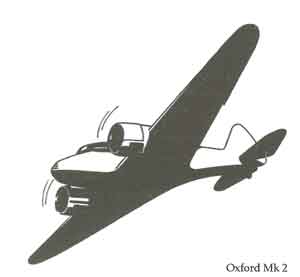
speed with one engine to assist a turn.

I soon found that I was
very lucky indeed if the particular aircraft I was flying could maintain height on one engine. Single-engined flight
usually meant that I was effectively in a power assisted glide with one leg shaking with the effort of keeping the
rudder hard over (in spite of full trim correction) to stop undue yawing. Such things were demonstrated to us very
early before we flew solo on type so as to be ready for such an emergency situation. I was told that I was particularly
fortunate because I had long legs. If keeping the rudder over was hard for me,
heavens knows what agonies a shorter pilot had to suffer.

While on the subject of asymmetric flight (it was always included in flying proficiency tests) I opted, when doing a single-engine approach, to throttle back the
live engine and do what was in effect a glide approach and landing.
3 I found this
much easier than adjusting rudder pressure when throttling back the good engine to
adjust or maintain approach speed. I felt more comfortable at the much steeper
angle of approach and was never criticised for doing this.

It was important, although not essential, having taken off and throttled back into a normal climb, or level flight, to synchronise engines. That is, to eliminate the
thrum thrum thrum of the combined noise of both engines going into and out of
phase. On some aircraft the throttle positions were quite different for each engine in
order to achieve this, even though the tachometers were reading approximately the
same speeds. Once synchronised, should the engines then go out of synchrony, it
was wise to check all engine instruments and settings to ensure nothing was going
amiss like an impending engine failure or, more likely, one of the throttle levers
moving because the tensioning screw hadn't been tightened enough.

I flew 6 hours dual before my first 15 minute solo flight. By the end of
September I had flown over 11 hours dual and over 9 hours solo. Instead of
aerobatics, instrument flying, formation flying, night flying, and cross-country
navigation, were to become major components of our training.

It was widely held that should an Oxford go into a spin, and if recovery was not
initiated and successful within the first two turns, the spin would flatten out and
stabilise to the point that recovery was assumed to be unlikely and a crash
inevitable. Just in case such a situation arose, there was a knotted rope down the
fuselage from the pilots' seats to the door near the tail. With this, by 'climbing' along
it, over the main spar, and against the centrifugal forces of the spin, we were
supposed to be able to reach the door, jettison it, and hopefully bale out. I never
heard of this actually happening to any course students but doubtless such things
must have occurred during the 14 years or more that Oxfords had been in RAF
service.

Usually my instructor was Ken Knott but occasionally Fg.Off. Len Higgens, a Volunteer Reserve pilot, would stand in for him. Len was a little more daring in his
______________________________________
3 Asymmetric flight = Flying on one engine.
26







